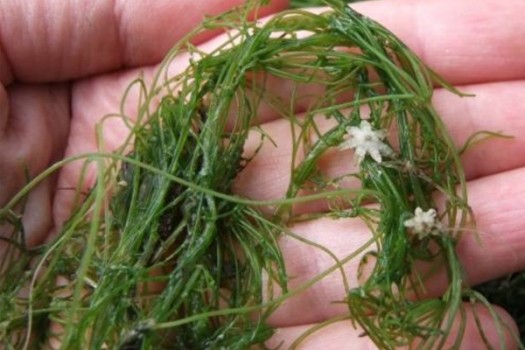The Minnesota Department of Natural Resources has confirmed a small population of the invasive algae starry stonewort in Lake Beltrami, near Bemidji in Beltrami County.
Last August, a volunteer found a strand of starry stonewort near the public access in Lake Beltrami during the University of Minnesota Extension’s annual “Starry Trek” event. Subsequent searches and ongoing monitoring did not reveal any additional starry stonewort in the lake until last weekend.
DNR divers confirmed starry stonewort in a three-foot area, two smaller areas, and separate strands tightly intermingled with a high diversity and abundance of native chara and aquatic plants. Starry stonewort is similar to chara in appearance, but starry stonewort has telltale star-shaped bulbils that typically aren’t visible until August.
DNR divers will be hand-pulling starry stonewort at intervals through the rest of the summer as a way to manage the biomass. Boat inspections have been expanded and follow-up surveys will be conducted to watch for the invasive algae in other parts of the lake.
Starry stonewort has never been eradicated from any U.S. lake, but treatment or careful removal can help reduce the risk of spread and reduce the algae’s adverse impact on water-related recreation.
Starry stonewort was first confirmed in Minnesota in 2015. It has now been confirmed in 15 of Minnesota’s 11,842 lakes.
Now is the best time of year to look for this invasive. Information on how to identify starry stonewort can be found on the DNR’s website. If people think they’ve found starry stonewort, they should report it to the DNR.
Starry stonewort is an alga that looks similar to other native plants and can form dense mats, which can interfere with use of a lake and compete with native plants. It is most likely spread when fragments have not been properly cleaned from trailered boats, personal watercraft, docks, boat lifts, anchors or other water-related equipment.
The DNR reminds boaters and anglers to follow Minnesota laws to prevent the spread of aquatic invasive species:
- Clean aquatic plants and animals from watercraft.
- Drain all water by removing drain plugs and keep drain plugs out while transporting watercraft.
- Dispose of unwanted bait in the trash.
Some invasive species are small and difficult to see at the access. To remove or kill them, take one or more of the following precautions before moving to another waterbody, especially after leaving infested waters:
- Spray with high-pressure water.
- Rinse with very hot water (120 degrees for at least two minutes or 140 degrees for at least 10 seconds).
- Dry for at least five days.
Details about starry stonewort and other aquatic invasive species are available at mndnr.gov/ais.
Tags:



